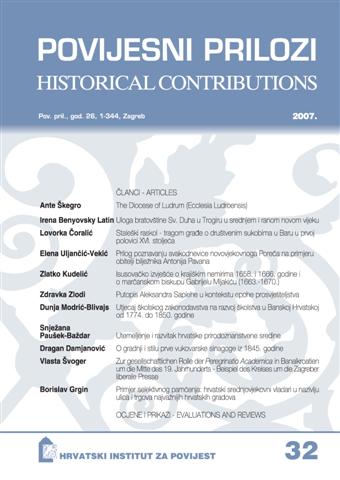Uloga bratovštine Sv. Duha u Trogiru u srednjem i ranom novom vijeku
A role of the Holy Spirit fraternity in the medieval and early modern Trogir (Traù)
Author(s): Irena BenyovskySubject(s): History
Published by: Hrvatski institut za povijest
Keywords: Trogir (Traù); Middle Ages; fraternity of the Holy Spirit; fraternity’s statute
Summary/Abstract: Development of the Trogir’s fraternity of the Holy Spirit depended on several elements: a common emergence of such fraternities in Europe, social and political position of commoners in Trogir during the fourteenth and fifteenth centuries, as well as the maintenance of city’s hospital which probably was under the influence of hospitaler’s order of Santo Spirito. It is important to stress that the period of the fraternity emergence (together with the city’s hospital) conveys with the urban growth of Trogir. Members of the fraternity came from various social groups but leadership was always under the influence of the rich citizens. The importance of this fraternity was such that during the rule of Louis the Great this was the only fraternity in Trogir that was not abolished in 1365. During the fifteenth century this fraternity was leading, so called, commoners council, which was a kind of opponent to the city’s council of noblemen. Investigation of the fraternity’s statute (matrikula) revealed that fraternity of the Holy Spirit owned a significant amount of mobile and immobile property. The chief income was coming from the gifts, mostly from testaments. Because of this wealth the fraternity was economically independent and often communal turbulences did not affect it. In 1442 all the property of the fraternity was evaluated and listed: the fraternity possessed 60 possessions in the city’s district, several houses within the city walls among which some were rented. With these incomes fraternity financed maintenance of the hospital. All the possessions of the fraternity were supervised by fraternity’s župan (headmaster). The extent documents reveal dynamics of the fraternity’s business, rents and loans. The fraternity’s statue contains approximately 470 names of fraternity members over the period of 160 years (1429-1589). Some of the fraternity members were prominent citizens, holding a significant property in the city and performing various important offices. Therefore, the fraternity of the Holy Spirit in Trogir represented an important political, social and economic institution that significantly influenced culture of medieval and early modern Trogir.
Journal: Povijesni prilozi
- Issue Year: 2007
- Issue No: 32
- Page Range: 25-61
- Page Count: 36
- Language: Croatian

